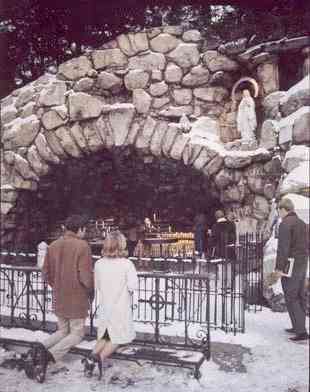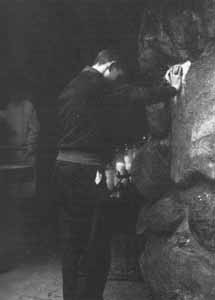
Notre Dame's Grotto / by Dorothy V. Corson


110 Year Lourdes Celebration at Notre Dame
Many pictures of this 1958 Centennial of the Lourdes Grotto in France, celebrated on the campus, were evident, but none showed the black stone in place at that time. Then the discovery of an old 1968 Our Sunday Visitor (243) -- with a cover picture of the Grotto and an article detailing the 110 year celebration of the Lourdes Grotto held at Notre Dame in 1968 -- showed clearly the large black stone. It looked like it had been freshly cemented into the Grotto. Father Schaerf, in ill health, had left his post as pastor of the Sacred Heart Parish in 1960. He left the order and his work with the Confraternity in 1968. Could the black stone have been a farewell gesture?A thorough search through the Domes and the Scholastics, just to be sure, finally produced a 1958 picture which provided proof of the first appearance of the black stone at the Grotto. It was placed there in 1958, rather than in 1968 as the picture on the cover of the old Our Sunday Visitor had suggested. As Father O'Connor had indicated, Father Schaerf must have put it there, without fanfare, in secret, sometime after the ceremonies. This might explain why nothing was written about it at the time and why it didn't show up in any pictures taken during the formal celebration.
 One page in the Sacred Heart Church Archives produced the answer to one more unsolved item of interest. A copy of an article from a 1958 Scholastic concerning the black stone was filed away in the last folder checked. It was not indexed in the Scholastic catalog file. It is unlikely it would have been found any other way. Along with the article, was a photograph of a student leaning on the Grotto wall with his head bowed in prayer and his hand on the black stone:
One page in the Sacred Heart Church Archives produced the answer to one more unsolved item of interest. A copy of an article from a 1958 Scholastic concerning the black stone was filed away in the last folder checked. It was not indexed in the Scholastic catalog file. It is unlikely it would have been found any other way. Along with the article, was a photograph of a student leaning on the Grotto wall with his head bowed in prayer and his hand on the black stone:
From the time the Notre Dame Grotto was dedicated, the most common expression of Notre Dame men's devotion to Mary has been in their regular visits to the Grotto. The similarity of our own Grotto to the Lourdes Grotto has been captured in fine detail here at Notre Dame. In fact, there is even a stone from the Lourdes shrine in our own Grotto; it was brought back to Notre Dame by Father Maguire, who had visited Lourdes.(244)
The missing piece Father Edward O'Connor had been unable to supply -- where the black stone Fr. Schaerf placed at the Grotto had come from -- had been found. It was an article that also revealed an interesting coincidence. The Father Maguire responsible for obtaining the black stone was the same Father Joseph Maguire who had written the letter correcting the misconceptions about the history of the Grotto. It is unlikely any of this research would have been attempted without it. Now, everything about the larger black stone began to fall into place.
The Notre Dame Public Relations publicity drop file on the Grotto produced information about the smaller Lourdes stone, which is directly above the larger one. It is barely visible to most people because it is small and the shade of the mortar appears to be the same as the Grotto. An article in their file sent to The New World,(245) a Chicago Diocesan magazine, solved that mystery too:
Directly beneath the elevated statue of Our Lady is a relic from the Lourdes Grotto. It is a small piece of rock from the niche in which the Blessed Virgin appeared. This relic was brought to the University by Rev. John F. DeGroote and was installed in 1939.
A check of the Indiana Province Archives revealed that Father DeGroote make a grand tour of Europe, including Lourdes, in 1939. Twenty years later, in 1958, Father Joseph Maguire also made a grand tour of Europe, with a two day stopover in Lourdes, for his 50th anniversary. Both of them must have had the same thought in mind. This information supplied the story behind the two black stones from Lourdes now at the Grotto.
Father Schaerf was pastor of the Sacred Heart Church from 1957 to 1960. Father Maguire would have been in his 80s. It would be reasonable to assume, that due to his age, he would have been unable to arrange to place the black stone at the Grotto himself and turned it over the Father Schaerf to accomplish. Father Maguire died in his 90s in 1964. Those who lived with him in his retirement years, remember seeing him, well up in years, skating on the lake in the wintertime.
It is understandable that those who have visited Lourdes in France would want to bring back a tangible remembrance of their visit there. Stones have a special fascination. From little on up many people are attracted to stones and shells, probably because each is unique, like people, no two are exactly alike.
A last trip to the site of the Grotto in the Glen to take additional pictures on a sunnier day, produced one of these interesting mementos. A small eye-catching dark rock protruded from the rubble covered bank of dirt, sloping away from the side of the narrow lane, along the hill leading to the top of the bluff. It was about the size of a fist, smoky black and covered with dirt, but the sunlight caught a little glitter in it. One side was smooth and flat. It looked like it would make a good paperweight. A good soak in a pan of soapy water, overnight, transformed it. Once dried, and viewed under a lamp, tiny sparks of light gleamed every way it was turned. It turned out to be a hunk of black hematite, normally a Michigan mineral, a bit out of place in this area. It became a special remembrance of that springtime excursion into the glen in search of the island and the long forgotten grotto.
Black stones in ages past have had a very special spiritual significance. Finding it, fit in nicely with this later study of the two black stones from Lourdes that have become a integral part of the Notre Dame Grotto. The Grotto itself has that same unique appeal. The unhewn rocks used throughout, some boulders weighing as much as 2 or 3 tons, lend that touch of warmth and irregularity found in nature to its wooded knoll. There is something about it that is very pleasing to the eye and the soul.